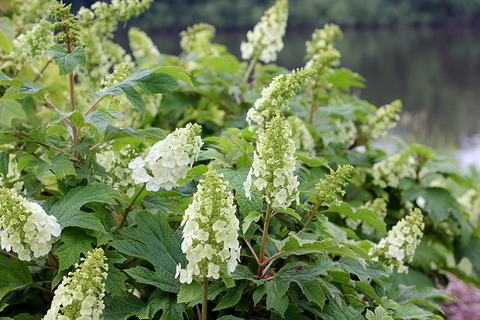Guide to Growing Oakleaf Hydrangeas

Contents:
Every landscape or garden needs an oakleaf hydrangea! These beautiful North American natives have so much to recommend them: bold foliage, big, fragrant summer blooms, the best fall color of any hydrangea, and in winter, dramatic peeling bark. Though they do need some time to get established in the garden before they begin to come into their own, they more than merit the patience they require. They are super reliable, long-lived, and as good for wildlife as they are for the human soul.
Hardiness/climate
Oakleaf hydrangeas are native to a wide swath of the Southeastern United States and are found abundantly from North Carolina south to Florida, and east into Louisiana. They are hardy to USDA zone 5, and as their steamy Southern range would suggest, very heat tolerant.
Size
In the wild, oakleaf hydrangeas reach some pretty generous proportions: up to 10'+ tall and wide under ideal growing conditions. Fortunately, the cultivated varieties that we have selected offer a broad range of more landscape-friendly sizes and habits, so with a bit of browsing, you'll find one that works for your space and taste.
Light
As with all hydrangeas, we do recommend some sun each day for oakleaf types. However, they are more shade tolerant than other kinds in that they still bloom pretty well in deep shade conditions. They also don't have the stem strength issues that you may observe with other types. If you do plant an oakleaf hydrangea in deep shade, be aware that its fall color will probably be muddy rather than bright and clear, there will be fewer flowers, and the habit may be a bit more open and sparse than a plant that gets at least some sun.
Soil
The standard moist, well-drained soil provides ideal growing conditions for oakleaf hydrangeas. That said, established plants can tolerate some drought, though it may shorten the lifespan of the flowers if dry conditions are severe and persistent. A 2-3" layer of shredded bark mulch is recommended all year-round to protect the shallow roots.
Fertilizer
Oakleaf hydrangeas need little to no special care when it comes to soil fertility. However, you may apply a granular rose fertilizer in early spring if you wish.
Flower Color
The flowers of oakleaf hydrangeas all start out white, creamy white, or with some green hints. A few varieties, like Gatsby Pink and 'Ruby Slippers', will develop nice pink/red coloration as the blooms age. However, this is a natural, genetic color change, and is not impacted by soil chemistry. If the blooms on these varieties turn brown instead of pink, that usually indicates the plant wasn't getting enough water or otherwise experienced stress during its bloom time.
Pruning
Oakleaf hydrangeas bloom on old wood, so avoid trimming them or cutting them back. You may selectively remove entire branches to enhance the overall look and habit of your plant, but regular pruning should be avoided.
Oakleaf hydrangea problems
Though they are largely problem-free, oakleaf hydrangeas do have a few minor issues to be aware of.
Diseases
Nearly all oakleaf hydrangeas may develop some minor leaf spot, particularly late in the season. This is not a cause for concern and will not impact the plant's health. You can help minimize any leaf spot issues by removing and discarding fallen foliage in autumn, avoiding overhead watering, and providing good air circulation.
Insects
Oakleaf hydrangeas are generally unbothered by insects. Any chewing that is seen typically does not require management of any kind.
Other animals
Oakleaf hydrangeas can experience some deer browsing, but they seem to be more of a second-choice plant for them, especially compared to favorites like panicle and smooth hydrangeas. This is likely due to the coat of white fuzz on the underside of the leaves. However, this doesn't mean that oakleaf hydrangeas are deer resistant - they typically browse plants to eat the flower buds and/or the tender tips of the branches, and in severe cases, this could remove the season's bloom entirely.
